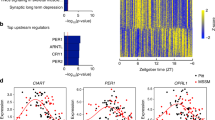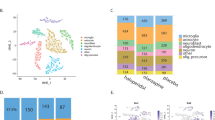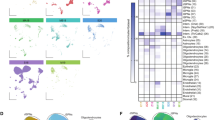Abstract
The human striatum can be subdivided into the caudate, putamen, and nucleus accumbens (NAc). In mice, this roughly corresponds to the dorsal medial striatum (DMS), dorsal lateral striatum (DLS), and ventral striatum (NAc). Each of these structures have some overlapping and distinct functions related to motor control, cognitive processing, motivation, and reward. Previously, we used a “time-of-death” approach to identify diurnal rhythms in RNA transcripts in these three human striatal subregions. Here, we identify molecular rhythms across similar striatal subregions collected from C57BL/6J mice across 6 times of day and compare results to the human striatum. Pathway analysis indicates a large degree of overlap between species in rhythmic transcripts involved in processes like cellular stress, energy metabolism, and translation. Notably, a striking finding in humans is that small nucleolar RNAs (snoRNAs) and long non-coding RNAs (lncRNAs) are among the most highly rhythmic transcripts in the NAc and this is not conserved in mice, suggesting the rhythmicity of RNA processing in this region could be uniquely human. Furthermore, the peak timing of overlapping rhythmic genes is altered between species, but not consistently in one direction. Taken together, these studies reveal conserved as well as distinct transcriptome rhythms across the human and mouse striatum and are an important step in understanding the normal function of diurnal rhythms in humans and model organisms in these regions and how disruption could lead to pathology.
This is a preview of subscription content, access via your institution
Access options
Subscribe to this journal
Receive 13 print issues and online access
$259.00 per year
only $19.92 per issue
Buy this article
- Purchase on Springer Link
- Instant access to full article PDF
Prices may be subject to local taxes which are calculated during checkout





Similar content being viewed by others
References
Haber SN. Corticostriatal circuitry. Dialogues Clin Neurosci. 2016;18:7–21.
Casale AD, Kotzalidis GD, Rapinesi C, Serata D, Ambrosi E, Simonetti A, et al. Functional neuroimaging in obsessive-compulsive disorder. Neuropsychobiology. 2011;64:61–85.
Cooper S, Robison AJ, Mazei-Robison MS. Reward circuitry in addiction. Neurotherapeutics. 2017;14:687–97.
Dickson DW. Neuropathology of Parkinson disease. Parkinsonism Relat Disord. 2018;46:S30–S33.
Middleton FA, Strick PL. Basal ganglia output and cognition: evidence from anatomical, behavioral, and clinical studies. Brain Cogn. 2000;42:183–200.
Weinstein JJ, Chohan MO, Slifstein M, Kegeles LS, Moore H, Abi-Dargham A. Pathway-specific dopamine abnormalities in schizophrenia. Biol Psychiatry. 2017;81:31–42.
Logan RW, McClung CA. Rhythms of life: circadian disruption and brain disorders across the lifespan. Nat Rev Neurosci. 2019;20:49–65.
Roenneberg T, Merrow M. The circadian clock and human health. Curr Biol. 2016;26:R432–R443.
Takahashi JS. Molecular neurobiology and genetics of circadian rhythms in mammals. Annu Rev Neurosci. 1995;18:531–53.
Ko CH, Takahashi JS. Molecular components of the mammalian circadian clock. Hum Mol Genet. 2006;15:R271–R277.
Panda S, Antoch MP, Miller BH, Su AI, Schook AB, Straume M, et al. Coordinated transcription of key pathways in the mouse by the circadian clock. Cell. 2002;109:307–20.
Yan J, Wang H, Liu Y, Shao C. Analysis of gene regulatory networks in the mammalian circadian rhythm. PLoS Comput Biol. 2008;4:e1000193.
Yoo SH, Yamazaki S, Lowrey PL, Shimomura K, Ko CH, Buhr ED, et al. PERIOD2::LUCIFERASE real-time reporting of circadian dynamics reveals persistent circadian oscillations in mouse peripheral tissues. Proc Natl Acad Sci USA. 2004;101:5339–46.
Chen C-Y, Logan RW, Ma T, Lewis DA, Tseng GC, Sibille E, et al. Effects of aging on circadian patterns of gene expression in the human prefrontal cortex. Proc Natl Acad Sci USA. 2016;113:206–11.
Ketchesin KD, Zong W, Hildebrand MA, Seney ML, Cahill KM, Scott MR, et al. Diurnal rhythms across the human dorsal and ventral striatum. Proc Natl Acad Sci USA. 2021;118:e2016150118.
Li JZ, Bunney BG, Meng F, Hagenauer MH, Walsh DM, Vawter MP, et al. Circadian patterns of gene expression in the human brain and disruption in major depressive disorder. Proc Natl Acad Sci USA. 2013;110:9950–5.
Seney ML, Cahill K, Enwright JF, Logan RW, Huo Z, Zong W, et al. Diurnal rhythms in gene expression in the prefrontal cortex in schizophrenia. Nat Commun. 2019;10:3355.
Mure LS, Le HD, Benegiamo G, Chang MW, Rios L, Jillani N, et al. Diurnal transcriptome atlas of a primate across major neural and peripheral tissues. Science. 2018;359:eaao0318.
Mitchell IJ, Cooper AJ, Griffiths MR. The selective vulnerability of striatopallidal neurons. Prog Neurobiol. 1999;59:691–719.
Graybiel AM. Habits, rituals, and the evaluative brain. Annu Rev Neurosci. 2008;31:359–87.
Hauber W, Schmidt WJ. Differential effects of lesions of the dorsomedial and dorsolateral caudate-putamen on reaction time performance in rats. Behav Brain Res. 1994;60:211–5.
Alegre-Cortés J, Sáez M, Montanari R, Reig R. Medium spiny neurons activity reveals the discrete segregation of mouse dorsal striatum. eLife. 2021;10:e60580.
Love MI, Huber W, Anders S. Moderated estimation of fold change and dispersion for RNA-seq data with DESeq2. Genome Biol. 2014;15:550.
Cornelissen G. Cosinor-based rhythmometry. Theor Biol Med Model. 2014;11:16.
Ketchesin KD, Zong W, Hildebrand MA, Scott MR, Seney ML, Cahill KM, et al. Diurnal alterations in gene expression across striatal subregions in psychosis. Biol Psychiatry. 2022. https://doi.org/10.1016/j.biopsych.2022.08.013.
Zhou Y, Zhou B, Pache L, Chang M, Khodabakhshi AH, Tanaseichuk O, et al. Metascape provides a biologist-oriented resource for the analysis of systems-level datasets. Nat Commun. 2019;10:1523.
Yamanishi K, Doe N, Sumida M, Watanabe Y, Yoshida M, Yamamoto H, et al. Hepatocyte nuclear factor 4 alpha is a key factor related to depression and physiological homeostasis in the mouse brain. PLoS ONE. 2015;10:e0119021.
Pan Y, Ballance H, Meng H, Gonzalez N, Kim SM, Abdurehman L, et al. 12-h clock regulation of genetic information flow by XBP1s. PLoS Biol. 2020;18:e3000580.
Díaz-Hung ML, Martínez G, Hetz C. Chapter Two - Emerging roles of the unfolded protein response (UPR) in the nervous system: a link with adaptive behavior to environmental stress? In: Kepp O, Galluzzi L, editors. International review of cell and molecular biology, Academic Press; 2020, vol. 350 p. 29–61.
Chaix A, Zarrinpar A, Panda S. The circadian coordination of cell biology. J Cell Biol. 2016;215:15–25.
Hombach S, Kretz M. Non-coding RNAs: Classification, biology and functioning. In: Slaby O, Calin GA, editors. Non-coding RNAs in colorectal cancer, Cham: Springer International Publishing; 2016. p. 3–17.
Ferretti V, Perri V, Cristofoli A, Vetere G, Fragapane P, Oliverio A, et al. Phosphorylation of S845 GluA1 AMPA receptors modulates spatial memory and structural plasticity in the ventral striatum. Brain Struct Funct. 2015;220:2653–61.
Sherwood CC, Stimpson CD, Raghanti MA, Wildman DE, Uddin M, Grossman LI, et al. Evolution of increased glia–neuron ratios in the human frontal cortex. Proc Natl Acad Sci USA. 2006;103:13606–11.
von Bartheld CS, Bahney J, Herculano-Houzel S. The search for true numbers of neurons and glial cells in the human brain: a review of 150 years of cell counting. J Comp Neurol. 2016;524:3865–95.
Ben-Shaanan TL, Azulay-Debby H, Dubovik T, Starosvetsky E, Korin B, Schiller M, et al. Activation of the reward system boosts innate and adaptive immunity. Nat Med. 2016;22:940–4.
Ben-Shaanan TL, Schiller M, Azulay-Debby H, Korin B, Boshnak N, Koren T, et al. Modulation of anti-tumor immunity by the brain’s reward system. Nat Commun. 2018;9:2723.
Brod S, Rattazzi L, Piras G, D’Acquisto F. ‘As above, so below’ examining the interplay between emotion and the immune system. Immunology. 2014;143:311–8.
Gremel CM, Costa RM. Orbitofrontal and striatal circuits dynamically encode the shift between goal-directed and habitual actions. Nat Commun. 2013;4:2264.
Pooters T, Gantois I, Vermaercke B, D’Hooge R. Inability to acquire spatial information and deploy spatial search strategies in mice with lesions in dorsomedial striatum. Behav Brain Res. 2016;298:134–41.
Carlén M. What constitutes the prefrontal cortex? Science. 2017;358:478–82.
Wang N, Langfelder P, Stricos M, Ramanathan L, Richman JB, Vaca R, et al. Mapping brain gene coexpression in daytime transcriptomes unveils diurnal molecular networks and deciphers perturbation gene signatures. Neuron. 2022;110:3318–3338.e9.
Funding
This work was funded by the National Institutes of Health DA039865, DA046346, MH111601, MH106460, NS127064 (PI: CAM), and MH128763 (PI: KDK), the Brain and Behavior Research Foundation (30823 (P&S Fund), PI: KDK), and the Wood Next Foundation (PI: CAM) (https://www.woodnext.org/).
Author information
Authors and Affiliations
Contributions
Conceptualization: KAP, CAM; Methodology: GT, CAM; Data acquisition: KAP, LMD, MRS, VGS, JNB, AJC, SMK, KDK; Data analysis: KAP, WZ; Writing: KAP, LMD, MRS, KDK, CAM.
Corresponding author
Ethics declarations
Competing interests
The authors declare no competing interests.
Additional information
Publisher’s note Springer Nature remains neutral with regard to jurisdictional claims in published maps and institutional affiliations.
Supplementary information
Rights and permissions
Springer Nature or its licensor (e.g. a society or other partner) holds exclusive rights to this article under a publishing agreement with the author(s) or other rightsholder(s); author self-archiving of the accepted manuscript version of this article is solely governed by the terms of such publishing agreement and applicable law.
About this article
Cite this article
Petersen, K.A., Zong, W., Depoy, L.M. et al. Comparative rhythmic transcriptome profiling of human and mouse striatal subregions. Neuropsychopharmacol. 49, 796–805 (2024). https://doi.org/10.1038/s41386-023-01788-w
Received:
Revised:
Accepted:
Published:
Issue Date:
DOI: https://doi.org/10.1038/s41386-023-01788-w



